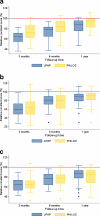Comparison of two different locking plates for two-, three- and four-part proximal humeral fractures--results of an international multicentre study
- PMID: 22127383
- PMCID: PMC3337113
- DOI: 10.1007/s00264-011-1410-8
Comparison of two different locking plates for two-, three- and four-part proximal humeral fractures--results of an international multicentre study
Abstract
Purpose: The aim of this study was to compare the functional outcome, quality of restoration, and complication rate after open reduction and internal fixation (ORIF) of displaced or unstable 2-, 3- and 4-part humeral fractures using two different locking plates.
Methods: The data used in this analysis was prospectively collected in two large multicentre studies in 15 European Level 1 trauma centres. A total of 318 patients with proximal humeral fractures were treated with ORIF using either the locking proximal humerus plate (LPHP) or proximal humeral internal locking system (PHILOS). Outcome measurements included Constant and Neer scores, evaluation of local pain at the fracture site and complications, and radiographic assessment at one year.
Results: At one year, the mean Constant scores (relative to the contralateral shoulder) improved significantly for both groups and were above 80% for 2-, 3-, and 4-part fractures. A significantly shorter surgical time, less pain at the fracture site, and better functional outcome was achieved by PHILOS-treated patients with 2-part fractures throughout the one-year follow-up month and with 3-part fractures at three months (p < 0.05). There was no difference between the treatment outcomes for 4-part fractures, and no difference in the complication rates (p > 0.05).
Conclusions: PHILOS and LPHP can be considered as useful implants for ORIF of displaced and unstable proximal humeral fractures. There was a slight advantage of the PHILOS system with regard to operative time and functional outcome, especially for the treatment of 2- and 3-part fractures.
Figures



References
-
- Sudkamp N, Bayer J, Hepp P, Voigt C, Oestern H, Kaab M, Luo C, Plecko M, Wendt K, Kostler W, Konrad G. Open reduction and internal fixation of proximal humeral fractures with use of the locking proximal humerus plate. Results of a prospective, multicenter, observational study. J Bone Joint Surg Am. 2009;91:1320–1328. doi: 10.2106/JBJS.H.00006. - DOI - PubMed
Publication types
MeSH terms
LinkOut - more resources
Full Text Sources
Medical

